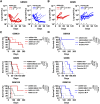Bystander Effects, Pharmacokinetics, and Linker-Payload Stability of EGFR-Targeting Antibody-Drug Conjugates Losatuxizumab Vedotin and Depatux-M in Glioblastoma Models
- PMID: 38743766
- PMCID: PMC11292202
- DOI: 10.1158/1078-0432.CCR-24-0426
Bystander Effects, Pharmacokinetics, and Linker-Payload Stability of EGFR-Targeting Antibody-Drug Conjugates Losatuxizumab Vedotin and Depatux-M in Glioblastoma Models
Abstract
Purpose: Antibody-drug conjugates (ADC) are targeted therapies with robust efficacy in solid cancers, and there is intense interest in using EGFR-specific ADCs to target EGFR-amplified glioblastoma (GBM). Given GBM's molecular heterogeneity, the bystander activity of ADCs may be important for determining treatment efficacy. In this study, the activity and toxicity of two EGFR-targeted ADCs with similar auristatin toxins, Losatuxizumab vedotin (ABBV-221) and Depatuxizumab mafodotin (Depatux-M), were compared in GBM patient-derived xenografts (PDX) and normal murine brain following direct infusion by convection-enhanced delivery (CED).
Experimental design: EGFRviii-amplified and non-amplified GBM PDXs were used to determine in vitro cytotoxicity, in vivo efficacy, and bystander activities of ABBV-221 and Depatux-M. Nontumor-bearing mice were used to evaluate the pharmacokinetics (PK) and toxicity of ADCs using LC-MS/MS and immunohistochemistry.
Results: CED improved intracranial efficacy of Depatux-M and ABBV-221 in three EGFRviii-amplified GBM PDX models (Median survival: 125 to >300 days vs. 20-49 days with isotype control AB095). Both ADCs had comparable in vitro and in vivo efficacy. However, neuronal toxicity and CD68+ microglia/macrophage infiltration were significantly higher in brains infused with ABBV-221 with the cell-permeable monomethyl auristatin E (MMAE), compared with Depatux-M with the cell-impermeant monomethyl auristatin F. CED infusion of ABBV-221 into the brain or incubation of ABBV-221 with normal brain homogenate resulted in a significant release of MMAE, consistent with linker instability in the brain microenvironment.
Conclusions: EGFR-targeting ADCs are promising therapeutic options for GBM when delivered intratumorally by CED. However, the linker and payload for the ADC must be carefully considered to maximize the therapeutic window.
©2024 The Authors; Published by the American Association for Cancer Research.
Conflict of interest statement
S. Rathi was a student at the University of Minnesota when the work was conducted. S.K. Gupta reports grants from NCI/NIH during the study, and AbbVie provided the ADCs used in the study. J.E. Eckel-Passow reports grants from NIH during the study. E.B. Reilly reports employment with AbbVie. J.N. Sarkaria reports grants from AbbVie Inc during the conduct of the study, as well as grants from Bayer, Wayshine, Black Diamond, Karyopharm, Boston Scientific, Wugen, Rain Therapeutics, Sumitomo Dainippon Pharma Oncology, SKBP, Boehringer Ingelheim, AstraZeneca, ABL Bio, ModifiBio, Inhibrx, Otomagnetics, and Reglagene outside the submitted work. No disclosures were reported by the other authors.
Figures






References
-
- Carlisle JW, Harvey RD. Tyrosine kinase inhibitors, antibody-drug conjugates, and proteolysis-targeting chimeras: the pharmacology of cutting-edge lung cancer therapies. Am Soc Clin Oncol Educ Book 2021;41:e286–93. - PubMed
-
- Dumontet C, Reichert JM, Senter PD, Lambert JM, Beck A. Antibody-drug conjugates come of age in oncology. Nat Rev Drug Discov 2023;22:641–61. - PubMed
MeSH terms
Substances
Grants and funding
LinkOut - more resources
Full Text Sources
Research Materials
Miscellaneous

